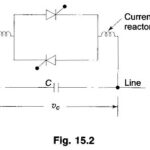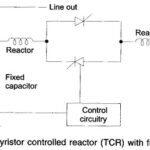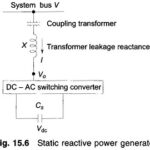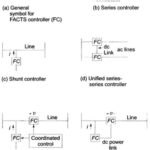Compensation in Power System Articles:
What is Compensation in Power System: Introduction to Compensation in Power System – For reduction of cost and improved reliability, most of the world’s electric power systems continue to be interconnected. Interconnections take advantage of diversity of loads, availability of sources …(Read More)
Limitations for Loading Capability of Transmission System: There are three kinds of limitations for loading capability of transmission system: Thermal Dielectric Stability Thermal capability of an overhead line is a function of the ambient temperature, wind conditions, conditions of the conductor, and ground clearance. There … (Read More)
Load Compensation in Power System: Load compensation is the management of reactive power to improve power quality i.e. V profile and pf. Here the reactive power flow is controlled by installing shunt compensating devices (capacitors/reactors) at the load end bringing about … (Read More)
Line Compensation in Power System: Line Compensation – Ideal voltage profile for a transmission line is flat, which can only be achieved by loading the line with its surge impedance loading while this may not be achievable, the characteristics of the … (Read More)
What is Series Compensation in Power System?: Series Compensation – A capacitor in series with a line gives control over the effective reactance between line ends. This effective reactance is given by where Xl = line reactance XC = capacitor reactance It is easy to see … (Read More)
What is Shunt Compensation in Power System?: Shunt Compensation are connected in shunt at various system nodes (major substations) and sometimes at mid-point of lines. These serve the purposes of voltage control and load stabilization. As a result of installation of … (Read More)
Difference Between SVC and Statcom: Difference Between SVC and Statcom may be noted that in the normal linear operating range of the V-I characteristic and functional compensation capability of the STATCOM and the SVC are similar. However, the basic operating principles … (Read More)
Concepts and Technology of Flexible AC Transmission Systems (FACTS): Flexible AC Transmission Systems – The rapid development of power electronics technology provides exciting opportunities to develop new power system equipment for better utilization of existing systems. Since 1990, a number of … (Read More)
Principle Operation of Switching Power Converters: Controllable reactive power can be generated by dc to ac switching converters which are switched in synchronism with the line voltage with which the reactive power is exchanged. A Switching Power Converters consists of an … (Read More)
Types of Facts Controllers in Power System: The development of FACTS controllers has followed two different approaches. The first approach employs reactive impedances or a tap changing transformer with thyristor switches as controlled elements, the second approach employs self-commutated static converters … (Read More)



